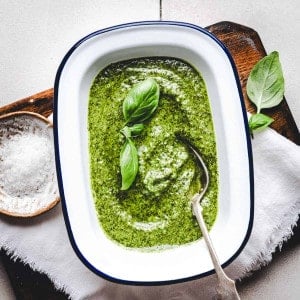This post may contain affiliate links. Please read our disclosure policy.
Pistou adds a burst of herbaceous flavor to any dish it graces. Originating in the Provence region of France, this vibrant blend of basil, garlic, parmesan, and olive oil is a testament to the simple elegance of French country cuisine.

Not only is it a brilliant accompaniment, but it requires just a handful of ingredients and 10 minutes of your time. The end result? A sauce that’s brimming with Mediterranean character, perfect for drizzling over pasta, stirring into soups, or spreading on crusty bread; it’s ready to uplift your meals from ordinary to exceptional.
Table of Contents
Ingredients You Need to Make Pistou

- Fresh Basil Leaves: Choose a bunch of fresh basil with bright green leaves that are perky and free from dark spots or wilting. When lightly crushed, they should release a strong, fresh basil aroma.
- Garlic: Look for firm cloves with a tight, unbroken skin. Avoid cloves that are soft, shriveled, or have begun to sprout.
- Parmesan Cheese: Choose Parmigiano-Reggiano or Grana Padano for an authentic flavor and texture.
- Olive Oil: Use an extra-virgin olive oil with a grassy, fruity aroma. Though unfiltered varieties can appear cloudy, their deep and robust flavors can enhance the Pistou.
- Sea Salt: Choose a finely ground, minimally processed sea salt without additives for the best flavor.
Pistou vs. Pesto: Two Distinct Sauces
While both Pistou and Pesto celebrate the aromatic allure of basil, their origins and compositions differ. Pistou sauce, especially beloved in the Provence region of France, is a simple blend of basil, garlic, and olive oil, often enhanced with a touch of Parmesan cheese.
Italian Pesto sauce, on the other hand, is native to Genoa in the Liguria region of Italy and has a richer flavor profile, incorporating pine nuts and sometimes a squeeze of lemon juice. The absence of nuts in Pistou gives it an herb-forward taste, where Pesto has more of a creamy, nutty undertone. Both are notable in their own right, each bringing a unique flavor character to a dish.
The Roots of Pistou in Provencal Cuisine
Pistou, a word derived from the Provençal dialect meaning “pounded,” has a history that’s deeply entwined with the culinary traditions of the Provence region in southeastern France, likely influenced by the neighboring Liguria’s famed Pesto. Over time, as olive groves and basil gardens thrived in Provence’s Mediterranean climate, the locals adapted the sauce to their tastes, often simplifying it by omitting nuts and cheese.
Today, Pistou has become emblematic of Provençal gastronomy. Its presence in everyday dishes, like the renowned “Soupe au Pistou,” underscores its significance in both rural and urban settings, serving as a testament to the region’s rich culinary traditions.

Mistakes to Avoid
- Overprocessing: While it’s tempting to blend the ingredients to a completely smooth texture, overprocessing can result in a loss of the individual flavors. Aim for a texture that maintains the character of each ingredient.
- Substituting Dried Basil: Fresh basil is essential for authentic Pistou. Dried basil won’t provide the same vibrant flavor or the right consistency.
- Compromising on Olive Oil: The quality of the olive oil plays a pivotal role in the Pistou’s flavor. Avoid low-quality oils that might detract from its richness and depth.
Recipe Tips
- Blending: Pulse the ingredients in short bursts rather than letting the blender or food processor run continuously. This technique helps achieve the desired texture and prevents overprocessing.
- Taste as You Go: Before serving, taste the Pistou and adjust the salt or olive oil as needed. Remember, it’s easier to add more than to fix an overly salty sauce.
- Using a Mortar and Pestle: For an authentic, rustic texture, use a mortar and pestle to grind the ingredients. This method might take longer but can provide a more traditional feel and taste to the Pistou.
Cheese Choices
While Parmigiano-Reggiano and Grana Padano are ideal, if they aren’t available, be sure the substitute is a hard, aged cheese for the best consistency and flavor. Here are some alternative choices:
- Comté: Produced in eastern France, this cheese is aged for various lengths of time. The older versions (aged 12 months or more) are firm and flavorful, with nutty and caramelized notes.
- Pecorino Romano: An Italian cheese made from sheep’s milk. It’s saltier and tangier than Parmigiano-Reggiano.
- Asiago: This cheese comes in both fresh and aged varieties. For Pistou, you’d want the aged version, called Asiago d’allevo, which is crumbly and has a stronger flavor.
- Manchego: A Spanish cheese made from sheep’s milk. Aged Manchego has a distinctive flavor and can be a good substitute.
How to Store
To preserve the bright green color of your Pistou, cover its surface with a thin layer of olive oil each time you store it in the refrigerator. (This layer seals the Pistou, blocking air and preventing sauce discoloration from oxidation.) Store it in a sealed container and use within 5-7 days. For longer storage, portion into ice cube trays and freeze. Once frozen, transfer the cubes to a freezer bag and use as needed.
More Basil Sauces: Pesto Variations to Try
How to Make Pistou
In a food processor, mince garlic, then add basil, parmesan, and salt, processing until well-blended. While it’s running, slowly add olive oil until combined. Adjust salt to taste, transfer to a bowl, and chill until ready to serve.




Pistou

Ingredients
- 1 large clove garlic peeled
- 2 oz fresh basil leaves ~2 packed cups
- 1/2 teaspoon fine sea salt or 1 teaspoon kosher salt
- 1/4 cup grated parmesan cheese
- 1/4 cup extra-virgin olive oil
Instructions
- With a food processor running add garlic through chute to mince. Scrape down the sides and add basil, parmesan cheese and salt; process until minced, scraping down sides as needed.
- With the food processor running, drizzle olive oil through the chute in a steady stream; process just until combined. (recipe note #2) Taste for seasoning and add more salt if needed. Transfer pistou to a small bowl. Cover and refrigerate until ready to serve. (recipe note #3)
Notes
- Or make with a mortar and pestle.
- If you’re making the pistou ahead of time, transfer to a small container and level the surface with the back of a spoon. Add a thin layer of olive oil to preserve its vibrant color; cover and refrigerate for up to one week.
Nutrition
Nutrition information is automatically calculated, so should only be used as an approximation.













